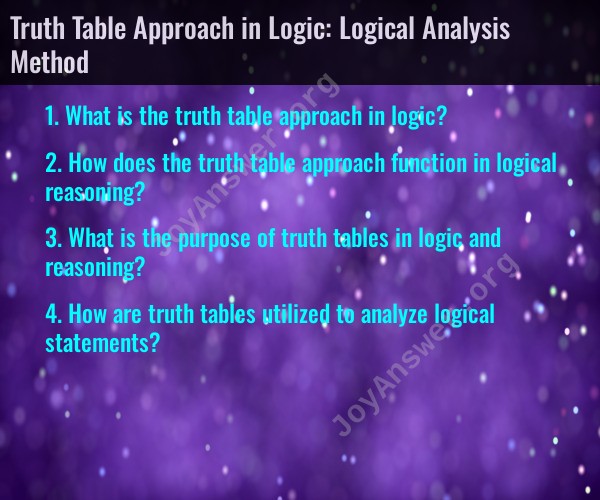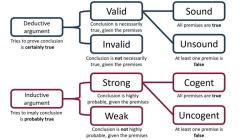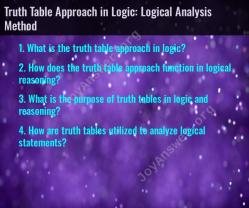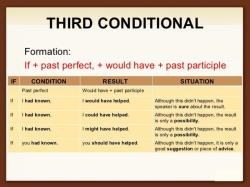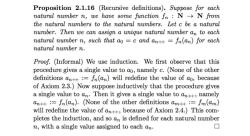What is the truth table approach in logic?
The truth table approach is a method used in logic to systematically analyze and evaluate the truth values of compound propositions or logical expressions. It provides a systematic way to examine all possible combinations of truth values for the component propositions within a compound statement. This method is particularly useful for determining the logical validity or equivalence of logical expressions.
Here are the key steps involved in the truth table approach:
1. Identify the Component Propositions:
- Identify the individual propositions or variables within the compound statement. These are the basic building blocks of the logical expression.
2. Determine the Number of Rows:
- Create a table with rows corresponding to all possible combinations of truth values for the component propositions. If there are n component propositions, there will be 2^n rows in the truth table.
3. Assign Truth Values:
- In each row, assign truth values (true or false) to the component propositions based on all possible combinations. There are 2^n possible combinations because each proposition can take either a true or false value.
4. Evaluate the Compound Proposition:
- Apply the logical operators (AND, OR, NOT, etc.) in the compound statement based on the assigned truth values for the component propositions. Determine the resulting truth value of the entire compound statement for each row.
5. Analyze the Truth Table:
- Examine the truth values in the last column of the truth table, which represents the truth values of the compound statement under different combinations of truth values for the component propositions.
- Determine whether the compound statement is always true (tautology), always false (contradiction), or sometimes true and sometimes false (contingent).
Example:
Consider the logical expression:
- Identify component propositions:
- Create a truth table with 2^3 = 8 rows.
- Assign truth values to in each row.
- Evaluate for each row.
- Analyze the truth values to determine the overall truth value of the compound statement.
| p | q | r | |
|---|---|---|---|
| T | T | T | T |
| T | T | F | T |
| T | F | T | T |
| T | F | F | T |
| F | T | T | F |
| F | T | F | F |
| F | F | T | F |
| F | F | F | T |
In this example, the compound statement is contingent because it is neither always true nor always false. The truth table provides a comprehensive overview of the possible truth values under different combinations of truth values for the component propositions.
How does the truth table approach function in logical reasoning?
Truth tables are a fundamental tool in logic and reasoning that provide a systematic way to evaluate the truth value of compound statements based on the truth values of their individual components. They work by tabulating all possible combinations of truth values for the component statements and determining the corresponding truth value of the compound statement.
What is the purpose of truth tables in logic and reasoning?
Truth tables serve several crucial purposes in logic and reasoning:
Determining the truth value of compound statements: By evaluating all possible combinations of truth values for the component statements, truth tables allow us to determine the truth value of any compound statement, regardless of its complexity.
Analyzing the logical relationship between statements: Truth tables reveal the logical relationship between statements, demonstrating how the truth value of one statement affects the truth value of another.
Identifying tautologies, contradictions, and logical equivalences: Truth tables can be used to identify tautologies (statements that are always true), contradictions (statements that are always false), and logical equivalences (statements that have the same truth value under all possible conditions).
Evaluating arguments and identifying fallacies: Truth tables can be used to evaluate the validity of arguments by determining whether the conclusion necessarily follows from the premises. They also help identify fallacies, which are errors in reasoning that lead to incorrect conclusions.
How are truth tables utilized to analyze logical statements?
To analyze logical statements using truth tables, follow these steps:
Identify the component statements: Break down the compound statement into its individual components, which are typically represented by lowercase letters (p, q, r, etc.).
Create the truth table: Construct a table with columns for each component statement and an additional column for the compound statement.
Fill in the truth values: Assign truth values (T for true and F for false) to each component statement for each possible combination of truth values.
Determine the truth value of the compound statement: For each row in the truth table, evaluate the compound statement based on the truth values of its components.
Analyze the results: Examine the truth table to determine the overall truth value of the compound statement. Identify tautologies, contradictions, and logical equivalences. Use the truth table to evaluate arguments and identify fallacies.
